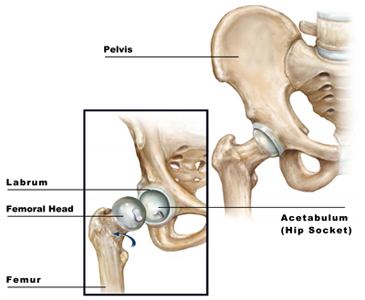Normal Anatomy of the Hip joint

The hip joint is composed of a ball and socket joint. The femoral head (ball) is the top of the femur (thigh bone) and the acetabulum (part of the pelvis) is the socket. These surfaces are both covered by articular cartilage, which is a specialized lining allowing smooth pain free motion of the joint. Damage to this lining result in arthritis.
The joint is lined by a specialized synovial layer, which secretes fluid helping with lubrication. Inflammation of this layer is called inflammatory arthritis the most common of which is rheumatoid arthritis.
The labrum is a specialized structure adding to stability of the joint. Damage to this structure can result in catching and pain in the joint. The capsule surrounds the synovium stabilizing the joint.
Bones
The hip joint is a ball and socket joint. The femoral head (ball) is the top of the femur (thigh bone) and the acetabulum (part of the pelvis) is the socket. These surfaces are both covered by articular cartilage, which is a specialized lining allowing smooth pain free motion of the joint.
Muscles
What is the Labrum?
Location & Function of the Labrum
The labrum is a ring of fibrocartilage (fibrous cartilage) that extends around the majority of the acetabulum, increasing its depth. The labrum acts as a suction seal around the femoral head maintaining the joint fluid within. The fluid protects the articular cartilage layers of the femur and acetabulum. The labrum does act as a stabilizer of the femoral head within the acetabulum as well.
Why does it tear?

Labral tears are typically the result of some underlying etiology.BONY , SOFT TISSUE, or TRAUMATIC
Bony
- Static Overload
- Femoral Anteversion
- Valgus Femoral Neck Orientation
- Acetabular Dysplasia (Anterior/Lateral)
- Dynamic Impingement
- Cam Impingement
- Femoral Retroversion
- Pincer Impingement
Soft Tissue
- PSOAS Impingement
- Laxity - Collagen Disorders
Traumatic
- Subluxation
- Dislocation
How does a labral tear present?
Labral tears most commonly result in "groin" pain. Most patients describe the pain as a sharp pain that is very deep. It tends to hurt more with increased activity, and is very easy to reproduce with high degrees of flexion and internal rotation of the hip joint. Prolonged periods of sitting will result in pain for patients with a condition known as femoroacetabular impingement.
Oftentimes, patients do not complain of a constant pain in the joint, but rather one that comes and goes without warning. Pain is usually located in the anterior region of the hip (groin area).
Less commonly, patients present with posterior (buttock area) or lateral (outside of the hip) pain.
Some complain of pain that wakes them up at night, or pain referred down the leg. These two symptoms tend to be more common in those with arthritis of the hip.
Why is it painful?
Patients with labral tear complain of hip pain because the labrum has nerve endings that can stimulate pain fibers, causing pain sensation in the hip region.

